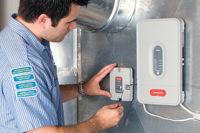Technical education is an often overlooked or disregarded option for students finishing up high school. According to a National Education Association (NEA) Research study, 51 percent of high school students do not go to college and 28 percent do not graduate from high school. What many of these students don’t realize is that they’re not alone or out of options. In total, around 70 percent of the U.S. labor force lacks a bachelor’s degree.
For those who do realize what a great option a career in the trades may be, HVAC may still fall down their list of preferred options, even though opportunities for growth and success are readily available.
In 2014, per a report from the HVACR Workforce Development Foundation, “70 percent of HVACR jobs were in middle-skill occupations that are traditionally open to workers without bachelor’s degrees, compared to only 20 percent of HVACR postings in high-skill occupations and 10 percent in low-skill occupations. On average, these HVACR middle-skill occupations average advertised salaries of $49,259.”
“One of the toughest problems to overcome is that most people don’t offhandedly know about HVAC,” said Tony Jordan, HVACR technician instructor at Blackhawk Technical College in Milton, Wisconsin. “They don’t know what it is or even what it stands for.”
BLACKHAWK BEGINNING
By expanding its offerings and locations, administrators at Blackhawk Technical College are hoping to increase the number of qualified technicians, as well.
In August 2014, the college moved its two-year HVAC program, as well as other manufacturing programs, into a new 105,000-square-foot facility, which is situated away from the school’s central campus.
In June, while the HVAC lab was still largely under construction and classes had not yet begun at the school, Jordan was optimistic the location change would positively impact the program.
“Thus far, enrollment has been tough, because the economy can be cyclical,” said Jordan. “But, with this new facility, we’re hoping to attract more attention to our program.”
Warren Lupson, director of education for the Air-Conditioning, Heating & Refrigeration Institute (AHRI), toured the facility while it was being built and was impressed with the center’s wide array of equipment.
Lupson’s been a vocal leader in proactively addressing the existing technician shortage before it overtakes the industry.
In 2013, while speaking to educators at the HVACR & Mechanical Conference for Education Professionals, Lupson said the industry, as a whole, can’t afford to not act on the impending work shortage.
“We [AHRI] are constantly donating equipment to schools like this for the specific purpose of training,” said Lupson. “Students need to be trained on a wide variety of equipment from many manufacturers because that is what they’re going to see out in the field.”
THE CURRENT REALITY
Jordan said a lack of attendance is the school’s biggest barrier. Though, he’s hopeful evolving technological advances will help bring new faces through the doors.
“It’s [a career in the trades] more glamorous than younger people realize, and there is a ton of innovation in the industry. Once young people see the technology, they really seem to like it and start to get it.”
Getting those young people to see the upgraded technology and the new equipment, both at Blackhawk Tech and nationwide, is consistently proving to be a difficult hurdle to overcome. Jordan said Blackhawk is currently enrolling 14-16 students in their classes while most classrooms can hold 18.
“For recruitment, we do frequent high school visits. The schools will bring us in and have seventh and eighth graders visit the school, too,” said Jordan. “We talk to technical education instructors and see if we can present program and our school to their students. They’re generally receptive to the idea, and that helps out a lot.”
For Jordan and Blackhawk Tech, the new facility is seen as a springboard to securing future students, but the program has been around for years and keeps track of graduates once they move into the workforce.
“We do keep track of our students after they graduate and have students now who are in all different sectors. From the feedback we’ve received, employers seem to like their work ethic and what they bring to the table,” said Jordan. “Sometimes, employers think they know too much and have to be trained to do things their way, but, overall, there have been few complaints.”
Jordan said Blackhawk’s committed to helping students find work as they graduate from the program.
“After their first year in the program, they’re encouraged to find employment,” said Jordan. “We have a lot of jobs around here that are not being filled. By the time our students graduate, they ideally have one year of real job experience already under their belts.”
Those jobs need to be filled in Wisconsin and around the rest of the country.
The aforementioned HVACR Workforce Development Foundation study also stated that HVACR jobs remain open for 34 days, which is slightly longer than the national average of 33 days. “However, postings for middle-skill HVACR jobs, which constitute the bulk of HVACR openings, remained open 12 percent longer than middle-skill jobs nationally.”
Blackhawk Tech is one school that’s moved locations and improved its facilities in an effort to draw in students and generate interest in the HVAC industry. The technician gap is still looming, but increased recruiting efforts and facility upgrades from schools across the U.S. are helping to address this growing concern.
Publication date: 12/21/2015
Want more HVAC industry news and information? Join The NEWS on Facebook, Twitter, and LinkedIn today!









